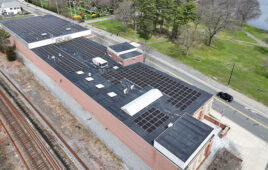We thought this post from First Solar, which concerns the ever-increasing importance of the Middle Eastern market, was a fascinating look at a market most in the United States don’t get to see. We have reposted it here with permission. You can see the full post and other posts from First Solar on their blog.
By Ahmed Nada, Special to Solar Power World
The 13 megawatt (MWDC) solar PV power plant in Seih Al Dahal, which was inaugurated on Oct. 22 by His Highness Sheikh Mohammed bin Rashid Al Maktoum, vice president and prime minister of the UAE and Ruler of Dubai, will generate more than 24 million kilowatt hours of electricity per year. Electricity generated by the power plant will displace an average of more than 15,000 metric tons of CO2 annually, equivalent to removing 2,000 cars from the road every year. Beyond the impressive statistics, however, the plant represents the Middle East’s solar energy sunrise: A pilot project that will help define how solar power plants are built in and around the region in the not-too-distant future.
The plant, built to the exacting, world-class standards of the Dubai Electricity and Water Authority (DEWA), is powered by First Solar’s Series 3 Black advanced thin-film PV modules, which not only incorporate record-breaking efficiencies, but are also certified for durability in harsh desert conditions.
In fact, the modules bring a number of benefits to the equation. For instance, their proven efficiencies, which have been certified by independent research laboratories, translate into better diffused light performance. In other words, the panels will continue to generate electricity on those, rare, cloudy days or in, humid dusty conditions. Certified for hot weather, the panels — and consequently, the plant— are designed to operate even in the hottest summer months.
Additionally, by selecting PV for the first phase of the Solar Park, DEWA has elected to conserve the country’s most precious resource: water. PV energy in general — and First Solar technology in particular — uses little to no water during operation, contributing to the efforts to address the traditional water-energy nexus. Significantly, the plant will help Dubai avoid the annual consumption of approximately 32,000 metric tons of water per year — sufficient to fill approximately 13 Olympic-sized swimming pools — from displacing thermoelectric power generation.
An equally important outcome of the project is the fact that as much as 50% of the cost of the plant was spent locally, ranging from the racks used to support the panels to the electrical components, including transformers, cables and switchgears — all of which were sourced from the UAE — contributing towards domestic economic growth and generating business for contractors and suppliers.
Even as the plant connects to the grid and UAE starts to reap the benefits of clean, affordable solar electricity, it will be important to pause and acknowledge the significance of this achievement. There is no doubt that this, the first phase of the Mohamed bin Rashid Al Maktoum Solar Park, is a game changer not just for Dubai but also for the solar industry. It establishes a much needed benchmark and demonstrates that solar PV, with its price and operational efficiencies, is the right fit for the region’s renewable energy needs.
Ahmed Nada is the vice president of business development for First Solar. You can see the full post and other posts from First Solar on their blog.






This is an interesting read but there’s no mention of Saudi Arabia, which has the greatest potential in terms of solar, nor of any other market outside of the UAE. While it’s a great look at Dubai and a First Solar customer, the title is misleading. Would be good to see more news on a region that is set to become a major adopter of solar power plants.